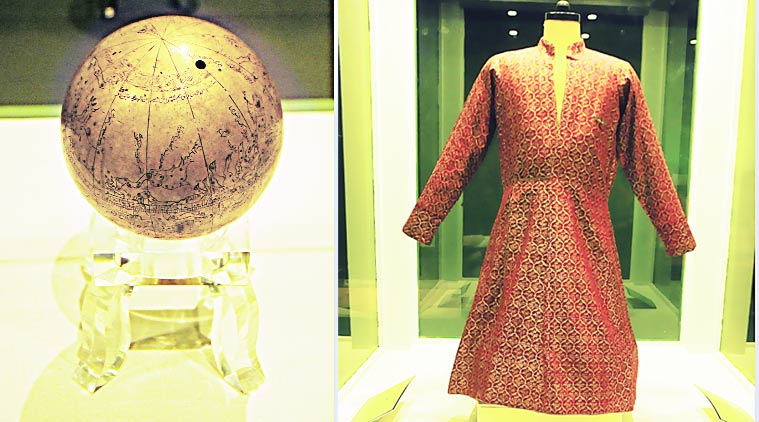- India
- International
Art of Lettering
With 56 artefacts from over five centuries, an exhibition offers insight into the art of calligraphy
 A brass celestial globe, belonging to the period of Mughal emperor Shah Jahan;(right) a deep earthy maroon silk gown, titled Choga.
A brass celestial globe, belonging to the period of Mughal emperor Shah Jahan;(right) a deep earthy maroon silk gown, titled Choga.
An integral aspect of Islamic culture, the art of Islamic-style calligraphy has stood the test of time. We know of it through its recurring appearances in architecture and manuscripts. But the form of fancy lettering of Arabic-Persian inscriptions also embellished several objects of daily use, from jewellery to vessels, garments, flags and prayer mats. Five centuries of these artefacts have now been put together by the National Museum in Delhi.
The two-month-long exhibition “Art of Calligraphy and Beyond: Arabic-Persian Inscriptions on Decorative Arts objects”, focusses on inscriptions beyond the conventional media of paper and architecture. The artefacts on display include a decaying 18th-19th century Talismanic tunic, spun in cotton, with sudoku grid-like motifs and the Naskh script of the Arabic language clearly visible on its surface. A scissor cast in iron and gold from Rajasthan from the late 18th century, meanwhile, has arms in the shape of letters in the same script and a deep earthy maroon silk gown, titled Choga, accentuated with metal threads, has inscriptions in the Naskh script running through its vast surface. Lota, a copper water vessel with its roots in southern India, has engravings of the Naskh script as well.
Curated from the museum’s reserve collection, the 56 utility artefacts have been categorised into five groups — writing
implements, religion, faith, tradition and trade. The display ranges from costumes to textiles, woodwork, metal instruments, bowls, pen cases, bracelets, amulets, wooden boxes and utensils. Qalamdan is a pen case intricately designed with golden motifs of leaves and flowers and the Nastaliq script of the Persian language — depicting how the calligraphers have made innovations in inscriptions.
The oldest is a 1495 brass shallow bowl with calligraphy inscriptions on its surface, belonging to Sultan Sikander Lodi, that is inscribed with the name of its calligrapher, Mohmood Bin Mahammad Bin Haji Mahmood Farsi. Another brass celestial globe, belonging to the period of Mughal emperor Shah Jahan, also has its maker’s name, Mohammad Ibn Illahdad Humayuni Lahori. “Sometimes it increases its value, especially when the name of the patron or calligrapher is inscribed on the object,” says curator Anamika Pathak, pointing out that 20 artefacts in the exhibition have been tagged as being “extremely important”, as they are inscribed with the name of the calligrapher, date of manufacturing or the name of the owner. She adds, “Calligraphy reflects your own personality and helps in knowing the traits of a person. If you have poor handwriting, it means you are fickle-minded. To write beautiful calligraphy, you have to be very calm and peaceful.”
Apr 25: Latest News
- 01
- 02
- 03
- 04
- 05




































